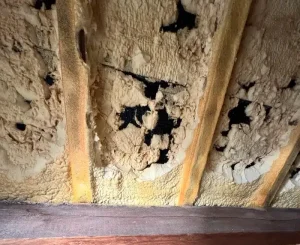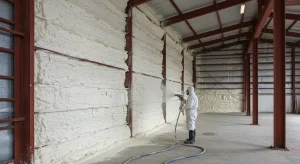Introduction
Spray foam insulation is widely used in residential and commercial buildings for its energy efficiency, air-sealing properties, and durability. While it offers numerous benefits, questions about its safety often arise. Understanding the materials, potential health risks, and proper installation practices is essential for homeowners and business owners considering this insulation method.
What is Spray Foam Insulation?
Spray foam insulation is a polyurethane-based material that expands upon application, filling gaps and creating an airtight seal. It comes in two main types:
- Open-cell foam: Softer, more flexible, and allows some air and moisture permeability.
- Closed-cell foam: Denser, with a higher R-value, offering better moisture resistance and structural reinforcement.
This insulation is known for reducing energy costs, improving indoor comfort, and preventing mold growth. However, proper installation and safety precautions are critical to avoid potential hazards.
Safety Concerns and Considerations
Chemical Composition and Off-Gassing
Spray foam insulation contains isocyanates, polyols, and blowing agents that react during installation. Improper handling or curing can lead to:
- Off-gassing: When not fully cured, spray foam can emit volatile organic compounds (VOCs), which may cause respiratory irritation, headaches, or dizziness.
- Chemical exposure: Direct skin or eye contact with uncured foam can lead to irritation or sensitization.
Professional installation with proper ventilation minimizes these risks. The curing process typically lasts between 24 to 72 hours, after which off-gassing significantly reduces.
Fire Safety and Toxic Fumes
Spray foam is highly flammable during application and requires fire retardants for safety. If exposed to high heat or flames, it can release toxic fumes, including carbon monoxide and hydrogen cyanide. Fire barriers or coatings can help mitigate these risks.
Indoor Air Quality Impact
If improperly installed, spray foam insulation may contribute to poor indoor air quality by:
- Trapping pollutants and moisture, leading to mold or mildew.
- Reacting with other building materials, releasing unexpected chemicals.
- Releasing odors, which may indicate incomplete curing or contamination.
Certified professionals follow best practices to ensure proper application, reducing the likelihood of these issues.
Ensuring Safe Installation
Hiring a Qualified Installer
Using a certified insulation contractor is key to safe and effective spray foam application. Professionals:
- Follow safety guidelines for mixing and applying materials.
- Ensure proper ventilation during and after installation.
- Use protective equipment to prevent exposure.
Post-Installation Ventilation
Allowing fresh air circulation after installation helps speed up the curing process. Keeping windows open and using fans or HVAC systems enhances air exchange, minimizing lingering odors or off-gassing effects.
Protecting Occupants and Pets
During installation and curing, it is recommended to vacate the premises. Infants, elderly individuals, and pets are more sensitive to chemical exposure and should not re-enter until the foam is fully cured.
Comparing Spray Foam to Other Insulation Types
Fiberglass vs. Spray Foam
- Fiberglass: Non-toxic, easy to install, and cost-effective but may allow air leaks.
- Spray foam: Provides better air sealing but requires professional application and has chemical exposure risks.
Cellulose vs. Spray Foam
- Cellulose: Made from recycled paper, environmentally friendly, and less expensive but can settle over time.
- Spray foam: Longer lifespan, resists moisture, and provides superior thermal performance.
Mineral Wool vs. Spray Foam
- Mineral wool: Fire-resistant and soundproofing but lacks air-sealing properties.
- Spray foam: Insulates and seals gaps but requires careful handling.
Long-Term Health and Environmental Impact
Longevity and Structural Benefits
Spray foam can last over 50 years, maintaining its insulating properties and preventing air leaks. Closed-cell foam enhances structural integrity, particularly in commercial buildings.
Eco-Friendliness and Sustainability
- Many spray foams now use low-global-warming-potential (GWP) blowing agents.
- Proper insulation reduces overall energy consumption, lowering a building’s carbon footprint.
- Some manufacturers offer bio-based or recycled-content foam options.
Health Precautions for Sensitive Individuals
People with respiratory conditions or chemical sensitivities should consult an expert before choosing spray foam. Proper ventilation and low-VOC options help minimize exposure risks.
How to Address Common Concerns
Is Spray Foam Safe for DIY Installation?
While DIY kits are available, handling spray foam requires experience and safety precautions. Incorrect mixing, uneven application, or inadequate ventilation can lead to health hazards and poor insulation performance.
Will Spray Foam Cause Structural Damage?
Poorly applied spray foam can trap moisture or exert pressure on walls, potentially causing damage over time. Hiring professionals ensures proper application without compromising structural integrity.
Reliable Insulation Services
For expert spray foam insulation services, contact Flatland Roofing & Insulation at (806) 606-6794 or email info@flatlandroofcoatings.com. Our experienced team prioritizes safety, efficiency, and long-term performance.
FAQs
1. How long does spray foam insulation take to cure?
Most spray foams fully cure within 24 to 72 hours. During this period, it’s best to stay out of the area to avoid exposure to fumes.
2. Does spray foam insulation have an odor?
Yes, uncured spray foam can produce a noticeable smell. Proper ventilation helps dissipate any lingering odors.
3. Can spray foam be removed if needed?
Removing spray foam is difficult and labor-intensive. It may require cutting, scraping, or using solvents to break down the material.
4. Is spray foam insulation mold-resistant?
Yes, closed-cell spray foam resists mold growth by preventing moisture accumulation. However, improper installation can lead to trapped moisture, increasing mold risk.
5. Does spray foam insulation attract pests?
No, spray foam does not serve as a food source for pests, and it helps seal gaps that could allow entry.
6. Can spray foam insulation help reduce noise?
Yes, open-cell spray foam has soundproofing properties, reducing airborne noise between rooms or floors.
7. Will spray foam insulation void my home warranty?
This depends on the manufacturer and installer. Always check with your warranty provider before installation.
8. Is spray foam safe for metal buildings?
Yes, closed-cell spray foam is commonly used in metal structures to prevent condensation and improve thermal performance.
9. Can spray foam be applied over existing insulation?
In some cases, yes. However, it depends on the condition and type of the existing insulation. Consulting a professional is recommended.
10. Is spray foam worth the cost?
Although more expensive than traditional insulation, spray foam offers long-term energy savings, durability, and enhanced air sealing, making it a worthwhile investment.





